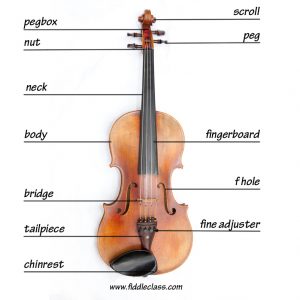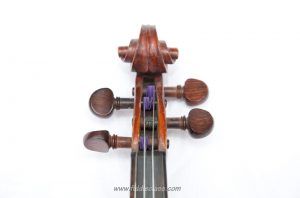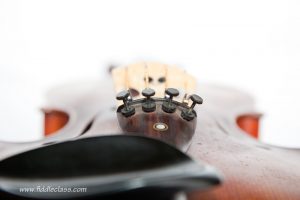The parts of a fiddle
If you need to ask someone to fix your fiddle, or want to ask about how to look after it, it can be useful to know what the different parts are called. Here’s a quick guide:

Working down from the top of the diagram:
The scroll
This is the decorative tip of the neck of the fiddle. Scrolls are generally carved in a spiral shape, but occasionally fiddles have carved heads at the scroll end.
The pegbox
The pegbox is the hollowed out area below the scroll. Each side of the pegbox has 2 holes where the pegs fit.
The pegs

There are 4 pegs on a fiddle. The shaft of each peg has a slight taper on it, so that the further the peg is pushed into the hole the tighter the fit. Each peg has a small hole through the shaft, where the end of the fiddle string is threaded through to hold the string in place. The pegs are used to tune the strings. Find out more about tuning your fiddle.
The nut
The nut is the raised area at the end of the fingerboard, which holds the strings just clear of the fingerboard where they pass out from the pegbox. There are 4 small notches in the nut, which hold each of the strings in the right place.
The neck
The neck of the fiddle stretches the fiddle strings out to the correct length. The fingerboard is glued on to the neck, providing a hard-wearing surface for stopping the strings when playing.
The body
The body of the fiddle acts as a soundbox, amplifying the sound created by the vibration of the strings.
The strings

If you look down the body of the fiddle when you’re ready to play it, this is how it appears. There are 4 strings. These are generally tuned to G (the lowest note, and the thickest string), on the left hand side, then D, then A, and then E (the highest note, and the thinnest string), on the right. The E string should have a small plastic sleeve on it where it sits on the bridge. If there is no sleeve, the string is under so much tension that it acts like a cheese wire, and will cut down into the bridge.
The fingerboard
The fingerboard is a short length of hard wood that is glued in place on the neck of the fiddle. It’s generally made from ebony.
The f holes
The two f holes (also sometimes called sound holes) are two holes in the front of the body of the fiddle which help the sound of the fiddle project more effectively from the instrument.
The bridge
The bridge holds the strings clear of the fingerboard. There are 4 small notches in the bridge, which hold each of the strings in place. The bridge should be lined up with the small notches on the inner side of the f holes. The bridge should also be positioned vertically on the fiddle – regular tuning fo the fiddle can gradually pull the bridge over, so it’s worth checking your bridge is still vertical from time to time.
The fine adjusters

If your fiddle has fine adjusters, they are used to accurately tune the string to the correct pitch. Some fiddles only have a fine adjuster on the e string.
The tailpiece
The tailpiece connects the strings to the base of the fiddle, and holds them taught.
The chin rest
The chin rest is separate to the fiddle, and is kept in place by an ingenious screwing mechanism. Chin rests come in a variety of designs, and may sit to the side of the tailpiece, or directly over the top of it.
Of course the fiddle is only half of the instrument. Find out about the parts of the fiddle bow
